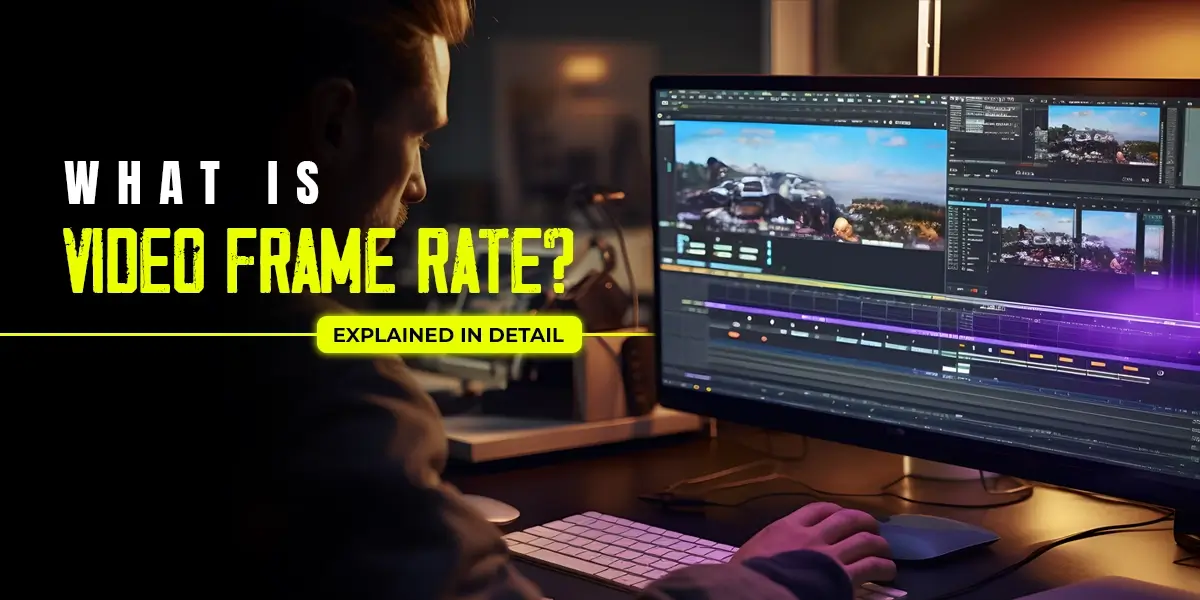What is Video Frame Rate? Explained in Detail
Human eyes perceive a movie or video as a single continuous, coherent recording. However, for the more curious folks reading this video frame rate article, the concept goes deeper than that. What happens is that video cameras or movie cameras record multiple images, also called frames; and when these frames are played back at a high speed, an illusion of motion is created. This apparently fluidic motion is what our eyes capture, letting us enjoy our favorite flicks.

The real magic lies in the frame rates. If you're new to video frame rates, this blog is for you. Any beginner in videography, movie-making, or gaming should understand frame rates and know the ideal one for their content. This guide discusses all that and more. Let’s begin!
What is frame rate?
In simple terms, the frame rate is the speed at which a recording device, like a video camera, captures individual static photos and projects them on a screen. Frame rate indicates the number of frames displayed or projected per second. If you want an even simpler explanation, we all have scribbled in flip books when we were young. Remember how the images on each page appeared to move when we flipped the book quickly? That’s the technique behind any video playback.
Regardless of the medium, feature films or web media, videos are the result of multiple moving images in quick succession, creating an illusion of seamless motion.
Now, each of these images is called a “frame” in video production jargon. The higher the frame rate, the smoother the video quality, and vice versa. A lower frame rate leads to shaky and blurry videos. Although not always, a higher frame rate is the benchmark for a great video. The ideal rate for each content depends on its purpose, narrative, and context.
Why frame is important for movies and online videos?
The importance of frame rate for videos lies in the fact that the ultimate viewing experience depends on this aspect. There are multiple frame rates, and each creates a different viewing experience, influencing the narrative style significantly. The settings you choose for your video set the kind of viewing experience it will yield to the viewers. Although wrong frame rates can be edited and increased during the post-production phase, it is always recommended to shoot the footage in the correct settings.
What is FPS?
As we speak about frame rates, FPS comes into the scene naturally. FPS or frame per second is the number of frames recorded in one second of a video or an animation. Simply put, it is the measurement unit of frame rates. An aspiring video editor must have a thorough understanding of FPS values. For instance, if a video is played at 24FPS, it means 24 still photos are displayed per second of the video.
Since the 1970s, when most recordings were made on 65mm films, 24FPS has been considered the industry standard. It was fast enough to create a seamless continuous motion illusion without any visual jerk or film wastage.
The video quality is also retained in this frame rate setting, along with perfect audio reproduction. 24FPS creates a cinematic viewing experience for day-to-day videos, travelogs, cinemas, gaming videos, etc. Basically, as sound and image were merged into one in movies, this standard saw its rise. That’s why it is deemed as the best video frame rate or FPS for cinematic movies.
Are shutter speed and frame rate different?
Besides knowing about frame rate for video, we must also know a few other things. Shutter speed is one of them. Inherently, these two concepts are different from each other, although both play equally important roles in photography and video production.
Shutter speed, also called exposure time, is the time how long the camera’s digital sensor or each frame is exposed to light while taking a photo. It is more relevant for photography. Since shutter speed impacts the opening and closing of the camera shutter, it also affects the shot’s exposure.
Therefore, a photographer can adjust the speed of the shutter to brighten or darken the photo. Shutter speed is also crucial for videos. A faster shutter speed can freeze motion, but a slower one can blur motion.
So, what do you mean by frame rate, and how is it different from shutter speed? As discussed above, frame rate is the indication of how many frames are squeezed into one single second while recording videos. It is a recording format that affects the viewing experience and can determine how smoothly the video can be played.
Which are the most commonly used video frame rates, and when to use them?
In the world of videography, ever since TV broadcast and sound synchronization became increasingly relevant, frame rates have also started getting more focus. Now, it is almost synonymous with videography and has been a pivotal part of the entire video production process.
There are several frame rates that not only have artistic impacts but are also technical requisites. When to implement which setting depends on the subject of your video and the visual effects you want in it. Check out the common video frame rates used worldwide.
-
24FPS
24FPS is the cinematic standard considered throughout the movie (feature films, documentaries), TV shows and online video production industry owing to the fact that the format has the most natural-looking appearance.
As per historical records, 24FPS eventually became the standard frame rate format because of its low usage of film, yet appearing significantly natural to the human eye. It was easier for the movie-maker to integrate audio and visual experience without wasting any extra film or causing any noticeable visual jerk.
Now, this multipurpose frame rate is mostly used for artistic choice, as well as for everyday videos, gaming animations, cinematic videos, etc.
-
30FPS
Primarily for live sports, TV shows, mega serials, and soap operas, 30FPS is used. As implied by the number, 30FPS consists of 6 extra frames per second than 24 FPS which gives it an even smoother appearance than the former. Especially for live TV, this frame rate is ideal, as well as a standard for smartphone cameras and apps.
-
60FPS
The perfect frame rate setting for creating or shooting slo-mo or slow-motion videos. It is a high frame rate in which some digital videos and films are shot that, when played, gives hyper-realistic looking footage.
While playing the footage back, it is slowed down to either 24FPS or 30FPS during the post-processing stage, creating a smooth, slow-motion visual effect. Hence, it is the quintessential slow-motion standard leveraged by most movie-makers. 60FPS is also used to record CGI like high-end computer video games to match computer screens’ refresh rates.
-
120FPS
This is one of the highest frame rates in video production and for creating an optimum gaming experience for pro-gamers. In this frame rate, as the name suggests, 120 individual pictures flow seamlessly per second in quick succession. That is why it is considered the best frame rate for PS5, creating a highly immersive gaming experience for the users.
One needs a high-end hardware device like a computer screen or TV that supports this high rate setting and 4K resolution.
Hope the above checklist, along with the simple tips on frame rate, will come in handy for editors, amateurs, and even individuals who want to create a great video.
Which is the best frame rate for modern videos?
Technically, there’s no “best”. Each rate setting has its own purpose, specific usage, and contribution towards making a video look natural and seamless. So, the best one is the one that works perfectly for your content. Just remember, the higher the rate, the smoother the video, and vice versa. Lower frame rates will often cause a choppy-looking video, distracting and frustrating the audience.
Keep in mind that the frame rate has a profound effect on a video and how the audience perceives it. For all types of YouTube videos, any configuration works, be it 24, 25, 30, 60, etc. So, what is a good frame rate? For classic urban documentary shots, select 24FPS, while for more engaging wildlife documentaries, a higher 30FPS or 60FPS works the best. To get perfectly optimized videos for YouTube, consider collaborating with an expert team offering stellar YouTube video editing services.
Also, once again, 60FPs is the ideal frame rate for slow-motion effects in modern videos and cinemas. If you ever wonder which is better, 30FPS or 60FPS, consider the purpose and usage of the video.
How to easily change the frame rate of a camera, and also from iOS, PC, and Android?
To modify a camera’s frame rate, access the video frame rate options of camera settings and select your desired fps setting. For more specific instructions, take a look at the user manual for your camera.
Most DSLRs do not allow altering the settings mid-recording. One has to typically set the right frame rate before starting the recording and remain consistent. Remember, changing or increasing the FPS setting impacts the final view of the video. Hence, it must be done meticulously. Check out the easy steps:
- Go to the menu or camera settings > Select video mode
- Then go to the frame rate options > Select the desired setting (20, 30, 50, 60)
- Adjust the rate based on your objective and the subject of the video. Start recording.
- For iPhone users, go to the Settings option > Select Camera
- Select Record Video and choose the frame rate you deem best.
PC users can try a few things to change or increase the frame rate of their webcams. As resolution and other settings also affect webcam frame rates, it is vital to fix those issues first. Disable the auto exposure option to generate higher frames consuming fewer resources. Also, turn off any filters and the white balance settings.
- Thereafter, navigate to the Start menu and search for the Camera option.
- In the Camera application, click the Settings icon at the top corner.
- Adjust the frame rate, camera quality, time-lapse, and many more.
- Click OK.
For PC gamers, try configuring your game settings, updating the graphics card, or using a high-end video cable. There are also online video frame rate converters that you can use from your PC to fix the video.
However, video post-production is a time-consuming job that requires prior video retouching knowledge and acute precision. Hence, it is always recommended to hire a professional company for any video post-production requirements instead of using online software.
Lastly, if you are an Android user and want to make any change in the FPS setting of your smartphone’s camera, click on the Camera icon to launch the application > Select Settings. Now, click on the Video quality option and select your desired setting.
Wrapping up
There you go! A detailed account of video frame rates and their different types. Hope it was an enjoyable and insightful read, and it will help anyone produce the best quality video content. Basically, when it comes to producing a great video or a movie, several factors come into play. Video resolution, aspect ratio, shutter speed, and frame rates must all be in perfect tandem for the final outcome to be a great hit.
With this handy guide, we believe our readers can be one step closer to choosing the proper FPS for their video projects, giving their audience the best viewing experience.




